The long and winding road the leads to . . . nowhere
A Column By Len Johnson
Monday, 23 November, was Labour and Thanksgiving Day in Japan. The annual public holiday for commemorating labour and production and giving thanks was also the day on which the Chiba International Ekiden Relay would have been run – had the race not been cancelled by the Japanese federation earlier this year.
Japan still has its numerous national, corporate, collegiate and high school ekidens, of course, but it seems that even in Japan the road relay is an endangered species. Most other places it’s extinct already.
The long and winding relay road increasingly leads not to your door, but pretty much straight into a cul de sac.
There’s mass participation events aplenty, but the days of athletics associations staging road races on public roads are either gone, or hanging by a thread.
Us Victorians like to think we are the home of distance running. Mostly that’s no idle boast. But consider the venues for the three individual road races and two relays which were on the Athletics Victoria winter calendar this year.
The 10km championship was held on the roads around Albert Park Lake. The 15km on a circuit around Ballarat’s Lake Wendouree and the half-marathon on the Yarra Boulevard at Burnley. All are nominally public roads, but each has the attribute of offering what is a virtually closed circuit. If they did not, the races would not be held there.
The two relays were the traditional Sandown Racecourse circuit (sacrilegiously raced the other way around, but that is another matter!) and the Ekiden Relay which was staged entirely off-road at Anglesea on Victoria’s Surf Coast. Sandown remains one of the most popular events on the Victorian calendar, Anglesea has great potential, but neither utilises public roads.
The Chiba cancellation was announced earlier in the year and I wrote then about Australia’s great involvement with the event (you can read that here).
Australia’s association with Japanese road relays actually started with two earlier events.
The first, in 1986, saw the IAAF trying to latch on to the Japanese road relay phenomenon – and build on the World Marathon Cup held in the same city the previous year – with a World Challenge Road Relay in Hiroshima in 1986.
An Oceania team comprising Australians Adam Hoyle, Andrew Lloyd and Steve Moneghetti and Kiwis Dave Burridge and Chris Tobin finished third in 2:00:12 behind Ethiopia (1:59:11) and Great Britain (1:59:14). New Zealand provided the manager, Len Searle, who commented that the result might have been better but for some delays getting the team to Japan.
The “delay” was caused by Hoyle and Moneghetti having to spend an extra day in Sydney getting Japanese visas which they had not known were required. Country boys both!
Two years earlier, in 1984, an Australian women’s team had been invited to compete in the Yokohama International Women’s Ekiden. The team of Donna Gould (Olympic 3000 metres representative later in the year), Sally Pierson, Anne Foley, Anne Lord, Tania Turney and Desiree Letherby (reserve: Jenny Lund), finished second in 2:23:50 splitting Great Britain (2:20:54) and the Soviet Union (2:25:24).
Tatyana Kazankina (the 1976 Olympic 800 and 1500 and 1980 1500 champion) ran the last leg for the USSR. Letherby said after the race she drove herself to the line repeating the mantra “Kazankina’s coming; Kazankina’s coming.”
Fifteen years later, Letherby’s son, Andrew, led off the third-placed Australian men’s team at Chiba with a 27:55 on the 10km opening leg. That’s one of two parent-child Australian performances in Japanese relays, the other being Lindy-Jane Trezise running for the first Australian women’s team at Chiba in 1988 and her daughter, Courtney Powell, running in the combined men’s and women’s team at the last Chiba in 2014.
While never having anything remotely like the major Japanese Ekidens, Australia has a significant history of road relays. There were point-to-point relay championships – the annual Melbourne-Geelong relay survived into the Clarke era – as well as regular club-versus-club events. In the pre-war era, when even less traffic was on the roads, the St Stephen’s Club promoted itself with relay runs from Melbourne to Adelaide.
There was an attempt to revive the public road relays with an Athletics Victoria race around the Mornington Peninsula in the late 1970s-early 1980s known, for its sponsor, as the Statewide Relays. More recently, the first AV Ekiden relay was run on back roads from Harcourt to Bendigo in Central Victoria.
Road relays are team events, but great individual clashes can still happen by chance. Or by creative coincidence when two great runners run the first leg, as at Chiba in 2003 when the world’s best female track runner, Berhane Adere of Ethiopia, and the best road runner, Paula Radcliffe, went head-to-head on the opening leg.
Sadly, there are fewer opportunities for such clashes to occur, a situation which does not seem likely to change any time soon.
You may still be able to get your kicks on Route 66, it’s just that they are less likely to involve road relays.
